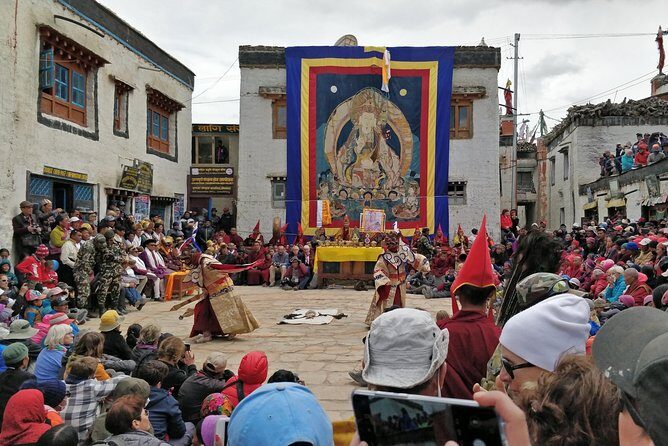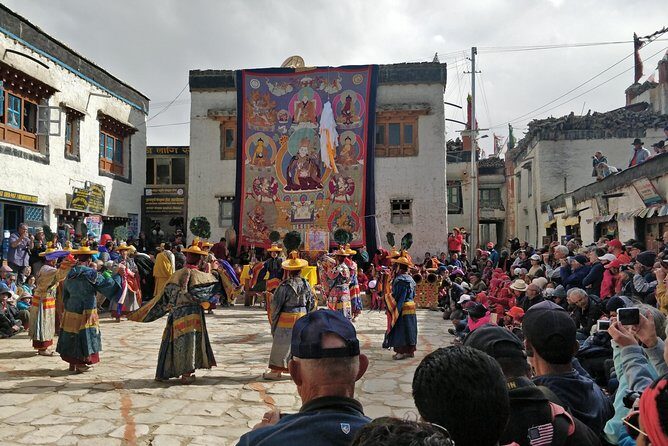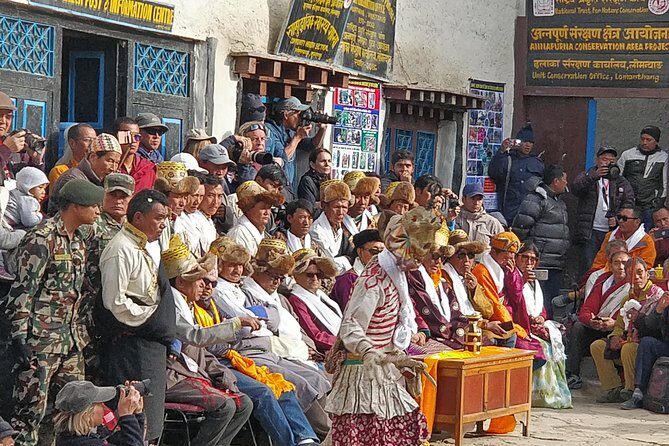Physical Address
304 North Cardinal St.
Dorchester Center, MA 02124
Physical Address
304 North Cardinal St.
Dorchester Center, MA 02124

Experience the vibrant Tiji Festival in Upper Mustang with this immersive trek, combining Tibetan rituals, stunning landscapes, and authentic cultural encounters.
Planning a trek that combines cultural richness with breathtaking landscapes? The Tiji Festival Trek in Upper Mustang offers just that — a chance to witness the colorful Tiji Festival while exploring some of Nepal’s most remote and dramatic terrain. This journey is as much about enjoying Tibetan traditions as it is about enjoying striking mountain views and authentic village life.
What we love most about this tour is how it balances culture with adventure, all supported by knowledgeable guides and comfortable accommodations. However, the trek’s moderate difficulty and the high-altitude sections mean it’s best suited for those with decent physical fitness and a sense of adventure. If you’re eager to experience a truly unique festival amid stunning scenery, this trek could be an unforgettable choice.
One possible consideration is the length and remote nature of the trek, which involves several long days of walking — sometimes up to 12 hours. It’s not for those looking for a quick trip or with mobility issues. But for travelers craving authenticity and a chance to witness Tibetan Buddhist traditions in a pristine setting, this tour hits the mark.
This experience is perfect for curious explorers who want more than just a sightseeing tour. It’s ideal for those who appreciate cultural stories, scenic landscapes, and the thrill of venturing off the beaten path.


Looking for more options in Kathmandu? Here are some other experiences worth considering.
Your adventure kicks off in Kathmandu, where you’ll spend a day preparing. This is your chance to meet your guide, finalize gear, and go over the detailed itinerary. It’s also an opportunity to soak up some local energy before heading to the mountains. The following day, you’ll transfer to Pokhara — a scenic 8-hour drive that offers glimpses of Nepal’s lush valleys and rural life.
From Pokhara, a short flight to Jomsom (2,715 meters) propels you into the Mustang region, saving you from a long, potentially tiring drive. The flight itself is a highlight, offering aerial views of the Annapurna range and surrounding peaks. Upon landing, you’ll begin your trek by walking to Kagbeni, a traditional village with monasteries and centuries-old architecture.
Over the next several days, you’ll traverse a series of villages such as Chele, Tsele, and Syangbochen. Each stop offers unique insights into local life, with stone-built houses and ancient monasteries that have preserved Tibetan traditions. The trek through these villages is usually between 4 to 6 hours daily, with some longer days, like the 12-hour trek from Chuksang to Muktinath.
Lo Manthang is the highlight — a walled city that feels like stepping back in time. During the festival, the town comes alive with colorful masked dances, Tibetan rituals, and community celebrations. Reviewers mention the Cham mask dance as a colossal impression. One traveler noted how the traditional ceremonies felt “unreal” and deeply meaningful, showcasing centuries-old reverence.
Over three days, you’ll get front-row seats to the festival’s main events. The festival commemorates the myth of a hero who saved Mustang from destruction, and the rituals are performed with reverence and vibrant costumes. Expect to see traditional dances, prayer rituals, and community feasts, all while surrounded by spectacular mountain scenery.
After the festival, the trek continues southward, with days walking to villages like Yara and Tengbe, and then a challenging day to Chuksang or Tsusang, often taking up to 12 hours. The route offers a mix of barren yet beautiful landscapes, with high passes and remote monasteries. The trip culminates with a flight from Muktinath back to Pokhara, a welcome change from the trekking days.
Finally, after a scenic drive back from Pokhara, you return to Kathmandu for a day of rest and exploration before departure. The trip concludes with your international flight, carrying memories of a rare cultural celebration in a truly untouched part of Nepal.
Beyond the stunning scenery, what we love about this tour is the inclusion of essential permits, all internal flights, and expert guides. We loved how the company provides detailed gear, like a duffel bag, trekking map, and even a T-shirt — small touches that make a difference. The accommodation during the trek is a mix of comfortable hotels and cozy tea-houses, giving you a taste of local hospitality without sacrificing comfort.
The cost of $2,895 per person might seem high at first glance, but considering the logistics — permits, flights, guides, and full-board meals — it offers a good value for a comprehensive, all-inclusive experience. Plus, the opportunity to witness the Tiji Festival in its full glory is a rare privilege, adding cultural depth to your adventure.
Reviewers consistently praise the guides, like Jeeban, for their expertise and ability to enhance the experience. They are especially adept at explaining the rituals, history, and significance of the festival, making it more than just a visual spectacle. This level of knowledge elevates the experience, allowing travelers to engage meaningfully with the culture.
Travel is facilitated by private vehicles, domestic flights, and a group size of just two — perfect for those who prefer intimacy and flexibility. The moderate difficulty level makes the trek accessible for most physically fit travelers, though some long days and high altitudes should be kept in mind.

This trek is ideal for culture enthusiasts eager to see Tibetan Buddhist traditions in their authentic setting. It’s well-suited for adventurous travelers with good fitness levels willing to handle multiple long trekking days and high-altitude passes. If you value small-group experiences with expert guides, this tour delivers.
Those looking for luxury might find the tea-house accommodations a bit rustic, but for most, the authentic experience outweighs the minor comforts. If you’re interested in combining cultural festivals with remote mountain scenery, this trek offers a rare chance.
The Tiji Festival Trek in Upper Mustang is a compelling journey that blends cultural discovery with striking natural beauty. It offers a rare glimpse into Tibetan Buddhist traditions, set against the backdrop of some of Nepal’s most dramatic and untouched landscapes. The knowledgeable guides, well-organized logistics, and authentic accommodations make it a worthwhile adventure for those who crave deeper culture.
While the trek involves some long days and high altitude, the rewards — from witnessing ancient rituals to exploring a fortress-like city — are well worth the effort. It’s perfect for curious travelers who want more than a typical trek, seeking instead a meaningful cultural experience in one of the world’s most remote corners.
If you’re ready for an authentic journey into Tibetan traditions, surrounded by jaw-dropping scenery, this trek deserves a serious spot on your travel list.
Is this trek suitable for beginners?
The trek is classified as moderate, so it’s best suited for travelers with decent physical fitness. The long walking days and high altitude may be challenging for complete beginners.
What is the best time to attend the Tiji Festival?
The festival takes place from May 24 to May 26, 2025, aligning with late spring when weather conditions are generally favorable.
Are flights included in the package?
Yes, the tour includes domestic flights from Pokhara to Jomsom and from Muktinath back to Pokhara.
How many days does the trek last?
The trek spans approximately 12 days of walking, plus arrival and departure days, making it a substantial but rewarding journey.
What kind of accommodation can I expect?
Accommodation is a mix of hotels in towns and cozy tea-houses along the trail, offering authentic local hospitality with basic comforts.
What makes the guides stand out?
Guides like Jeeban are highly praised for their expertise and ability to explain the cultural significance of the festival and local traditions, enriching the overall experience.
Is the trip suitable for children?
The minimum age is 18 years, and children must be accompanied by an adult. The physical demands mean it’s better suited for mature travelers.
What should I pack for this trek?
Bring layered clothing for variable weather, sturdy trekking shoes, a hat, sunscreen, and personal essentials. The tour company supplies a duffel bag and trekking map.
Are meals included?
Yes, breakfast, lunch, and dinner are provided during the trek, ensuring you stay energized through long days.
What is the maximum elevation reached?
The highest point reaches approximately 4,353 meters at Lo Manthang, so altitude acclimatization is important.
In summary, if you’re looking for a culturally immersive adventure with spectacular scenery, expert-guided insights, and the chance to witness a centuries-old festival in a remote Himalayan setting, this trek is a fantastic option. It balances adventure with authenticity, offering a truly memorable experience for those eager to go beyond typical tourist spots.